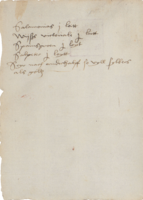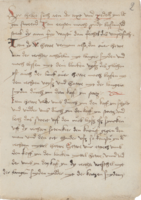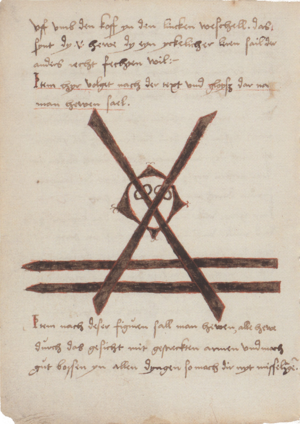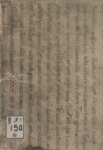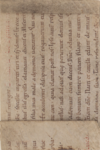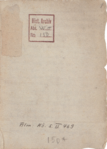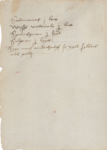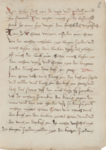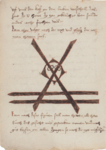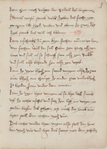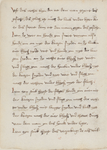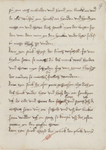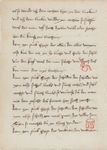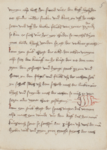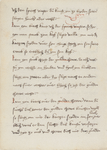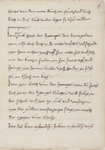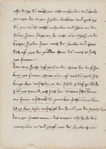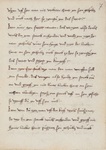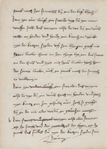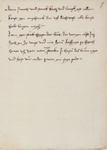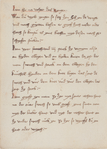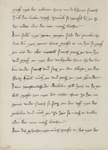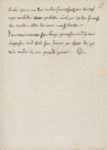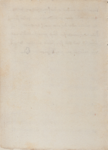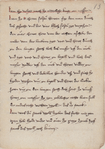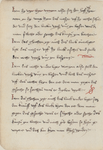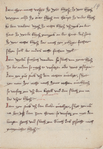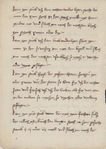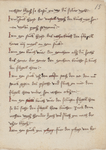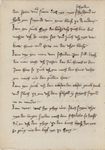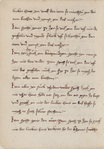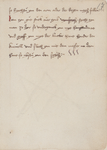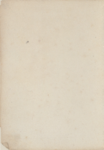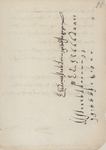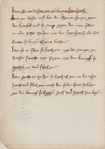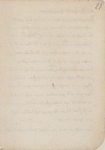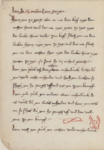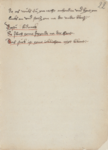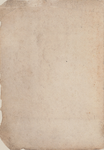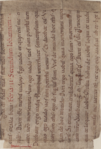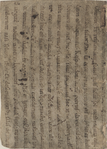|
|
You are not currently logged in. Are you accessing the unsecure (http) portal? Click here to switch to the secure portal. |
Difference between revisions of "Kölner Fechtregeln (MS Best.7020 (W*)150)"
| Line 115: | Line 115: | ||
| rowspan="4" | [[File:MS Best.7020 W-150 02v.png|300px|center]] | | rowspan="4" | [[File:MS Best.7020 W-150 02v.png|300px|center]] | ||
| <p>'''Item. The text and gloss follows hereafter [on how] one shall hew.'''</p> | | <p>'''Item. The text and gloss follows hereafter [on how] one shall hew.'''</p> | ||
| + | |||
| + | <p>Item. One shall hew according to these figures, all hews through the face with outstretched arms and make good position in all things, so you do not doubt yourself.</p> | ||
| {{section|Page:MS Best.7020 W-150 02v.png|2|lbl=-}} | | {{section|Page:MS Best.7020 W-150 02v.png|2|lbl=-}} | ||
| − | |||
| − | |||
| − | |||
| − | |||
|- | |- | ||
| Line 134: | Line 132: | ||
|- | |- | ||
| − | |||
| <p>Item. Understand the four openings in the sword thusly: The two over-openings on the head, the other two under-openings to both sides below the arms.</p> | | <p>Item. Understand the four openings in the sword thusly: The two over-openings on the head, the other two under-openings to both sides below the arms.</p> | ||
| {{section|Page:MS Best.7020 W-150 03r.png|3|lbl=-}} | | {{section|Page:MS Best.7020 W-150 03r.png|3|lbl=-}} | ||
| Line 161: | Line 158: | ||
|- | |- | ||
| | | | ||
| − | | <p>Item. One play called the enticement<ref>gamble, entice, pull to and fro</ref> | + | | <p>Item. One play called the enticement.<ref>gamble, entice, pull to and fro</ref> Act as if you wish to bind-on him right and bind-on him left and act as if you wish to bind-on him left and bind-on him right and hew yourself from the man strongly with the long edge into the left under-lier so that you are not to be found open.</p> |
| | | | ||
{{section|Page:MS Best.7020 W-150 03v.png|4|lbl=-|p=1}} {{section|Page:MS Best.7020 W-150 04r.png|1|lbl=04r|p=1}} | {{section|Page:MS Best.7020 W-150 03v.png|4|lbl=-|p=1}} {{section|Page:MS Best.7020 W-150 04r.png|1|lbl=04r|p=1}} | ||
| Line 204: | Line 201: | ||
|- | |- | ||
| | | | ||
| − | | <p>Item. One play called the ox<ref>alt: armpit</ref> | + | | <p>Item. One play called the ox.<ref>alt: armpit</ref> Understand the oxen thusly: Set the pommel upon the chest, the point against the opponent’s face and press<ref>alt: penetrate</ref> strongly into him and hew in the winger and quickly from the right side in the squint. Slash from the squint to the left over-opening and disappear<ref>alt: retreat, recede, vanish</ref> to the right, so that he must displace or become struck hard, etc.</p> |
| {{section|Page:MS Best.7020 W-150 05r.png|2|lbl=-}} | | {{section|Page:MS Best.7020 W-150 05r.png|2|lbl=-}} | ||
| Line 247: | Line 244: | ||
|- | |- | ||
| | | | ||
| − | | | + | | <p>Item. Whoever waits upon another’s hews,<br/>The permit their Art no joy.<br/>Hew-upon above whatever you wish<br/>No changer arrives in the shield<br/>To the head, to the body<br/>Do not omit the pull<ref>withdrawal</ref><br/>Alas, I say to you truthfully<br/>No man is without danger.<br/>If you frighten easily<br/>Never learn to fence<br/>There is no better displacement<br/>Than the one done with the strikes.<ref>sweeps</ref></p> |
| − | <p>Item. Whoever waits upon another’s hews,<br/> | ||
| − | The permit their Art no joy.<br/> | ||
| − | Hew-upon above whatever you wish<br/> | ||
| − | No changer arrives in the shield<br/> | ||
| − | To the head, to the body<br/> | ||
| − | Do not omit the pull<ref>withdrawal</ref><br/> | ||
| − | Alas, I say to you truthfully<br/> | ||
| − | No man is without danger.<br/> | ||
| − | If you frighten easily<br/> | ||
| − | Never learn to fence<br/> | ||
| − | There is no better displacement<br/> | ||
| − | Than the one done with the strikes<ref>sweeps</ref> | ||
| {{section|Page:MS Best.7020 W-150 06v.png|2|lbl=-}} | | {{section|Page:MS Best.7020 W-150 06v.png|2|lbl=-}} | ||
| Line 326: | Line 311: | ||
|- | |- | ||
| | | | ||
| − | | '''Item: Hereafter follows the wrestling.''' | + | | <p>'''Item: Hereafter follows the wrestling.'''</p> |
| − | When you wish to wrestle, then set your body in the scales and make good position. If he grabs you low or high, then you can it with these following written plays, etc. | + | |
| − | + | <p>When you wish to wrestle, then set your body in the scales and make good position. If he grabs you low or high, then you can it with these following written plays, etc.</p> | |
| − | + | | {{section|Page:MS Best.7020 W-150 10v.png|1|lbl=10v}} | |
|- | |- | ||
| | | | ||
| − | | Item: four weaks and 4 strongs, understand them thusly. On both elbows and on both knees, there the opponent is weak and strong on the elbow by the knuckle[sic]. The back of the knee, these are the weaks[sic] and in front of the knee and in front of the elbow, these are the strongs, etc. | + | | <p>Item: four weaks and 4 strongs, understand them thusly. On both elbows and on both knees, there the opponent is weak and strong on the elbow by the knuckle[sic]. The back of the knee, these are the weaks[sic] and in front of the knee and in front of the elbow, these are the strongs, etc.</p> |
| − | | | + | | {{section|Page:MS Best.7020 W-150 10v.png|2|lbl=-}} |
|- | |- | ||
| | | | ||
| − | | Item: If an opponent grabs at you with his right hand for your over weak, then grab around his arms with your left hand and back him into you with the right hand on the under weak so you throw him hard or soft, etc. | + | | <p>Item: If an opponent grabs at you with his right hand for your over weak, then grab around his arms with your left hand and back him into you with the right hand on the under weak so you throw him hard or soft, etc.</p> |
| − | + | | {{section|Page:MS Best.7020 W-150 10v.png|3|lbl=-}} | |
|- | |- | ||
| | | | ||
| − | | Item: The same for the left. If the opponent grabs at you with the left hand for your over weak, then grab around him with the right hand around his left arm and back him into you with the left hand [on] the under weak, so you throw him as before, etc. | + | | <p>Item: The same for the left. If the opponent grabs at you with the left hand for your over weak, then grab around him with the right hand around his left arm and back him into you with the left hand [on] the under weak, so you throw him as before, etc.</p> |
| − | | | + | | {{section|Page:MS Best.7020 W-150 11r.png|1|lbl=11r}} |
|- | |- | ||
| | | | ||
| − | | Item: A free play from the little weak. If an opponent grabs you on the left shoulder, then take him by the little weak with your right hand and with your left hand by the other weak, quickly shove his hand into his belly, so you throw him or the arm must break, etc. | + | | <p>Item: A free play from the little weak. If an opponent grabs you on the left shoulder, then take him by the little weak with your right hand and with your left hand by the other weak, quickly shove his hand into his belly, so you throw him or the arm must break, etc.</p> |
| − | | | + | | {{section|Page:MS Best.7020 W-150 11r.png|2|lbl=-}} |
|- | |- | ||
| | | | ||
| − | | Item: In all wrestling grab the opponent with short fingers. | + | | <p>Item: In all wrestling grab the opponent with short fingers.</p> |
| − | | | + | | {{section|Page:MS Best.7020 W-150 11r.png|3|lbl=-}} |
|- | |- | ||
| | | | ||
| − | | Item: If a strong opponent has grabbed you in the middle weak, then grab around the nearest weak with your right arm and sink yourself and grab with the other hand for the little weak. Yank the left foot back, so you throw him to the ground or the arm must break, etc. | + | | <p>Item: If a strong opponent has grabbed you in the middle weak, then grab around the nearest weak with your right arm and sink yourself and grab with the other hand for the little weak. Yank the left foot back, so you throw him to the ground or the arm must break, etc.</p> |
| − | | | + | | |
| + | {{section|Page:MS Best.7020 W-150 11r.png|4|lbl=-|p=1}} {{section|Page:MS Best.7020 W-150 11v.png|1|lbl=11v|p=1}} | ||
|- | |- | ||
| | | | ||
| − | | Item: If you wrestle an opponent and they are stronger than you [and] he grabs for you with one hand, then grab him with the over middle weak, shove him from you and grab him by the left under weak with the inverted hand and set the elbow in theheart's-keel, back him and shove him each other, etc. | + | | <p>Item: If you wrestle an opponent and they are stronger than you [and] he grabs for you with one hand, then grab him with the over middle weak, shove him from you and grab him by the left under weak with the inverted hand and set the elbow in theheart's-keel, back him and shove him each other, etc.</p> |
| − | + | | {{section|Page:MS Best.7020 W-150 11v.png|2|lbl=-}} | |
|- | |- | ||
| | | | ||
| − | | Item: Wrestling from the forks. Place yourself in the fork, if the opponent grabs at you with the right hand for an under weak, then hold him there with the forks and back him into you so he must fall or the arm must break, etc. | + | | <p>Item: Wrestling from the forks. Place yourself in the fork, if the opponent grabs at you with the right hand for an under weak, then hold him there with the forks and back him into you so he must fall or the arm must break, etc.</p> |
| − | | | + | | {{section|Page:MS Best.7020 W-150 11v.png|3|lbl=-}} |
|- | |- | ||
| | | | ||
| − | | Item: Also the same. If he grabs you for the under weak with the left hand, hold him there with an inverted fork, move him into you so he must fall or the arm must break, etc. | + | | <p>Item: Also the same. If he grabs you for the under weak with the left hand, hold him there with an inverted fork, move him into you so he must fall or the arm must break, etc.</p> |
| − | | | + | | |
| + | {{section|Page:MS Best.7020 W-150 11v.png|4|lbl=-|p=1}} {{section|Page:MS Best.7020 W-150 12r.png|1|lbl=12r|p=1}} | ||
|- | |- | ||
| | | | ||
| − | | Item: Whoever can make his art measured and it unforgotten [to himself] and holds his sword up high, they are good against four others in conflict, etc. | + | | <p>Item: Whoever can make his art measured and it unforgotten [to himself] and holds his sword up high, they are good against four others in conflict, etc.</p> |
| − | | | + | | {{section|Page:MS Best.7020 W-150 12r.png|2|lbl=-}} |
|} | |} | ||
| Line 398: | Line 385: | ||
|- | |- | ||
| | | | ||
| − | | '''Item. Hereafter follows the knightly art in the messer, etc.''' | + | | <p>'''Item. Hereafter follows the knightly art in the messer, etc.'''</p> |
| − | Item. The .f. hews. You shall hew freely through the face of the man and you shall not forget the four openings, etc. | + | |
| − | + | <p>Item. The .f. hews. You shall hew freely through the face of the man and you shall not forget the four openings, etc.</p> | |
| − | + | | {{section|Page:MS Best.7020 W-150 13r.png|1|lbl=13r}} | |
|- | |- | ||
| | | | ||
| − | | The over-hews hew from the right shoulder. The other from the left. Tread forwards and hew through into the long the stab. Lay<ref>There is a verb lechen which means: 'to lift up/draw back something spent, collect retrieve, etc' which is used a few times. look for 'lech' in the transcription.</ref> | + | | <p>The over-hews hew from the right shoulder. The other from the left. Tread forwards and hew through into the long the stab. Lay<ref>There is a verb lechen which means: 'to lift up/draw back something spent, collect retrieve, etc' which is used a few times. look for 'lech' in the transcription.</ref> the messer upon the back and tread forwards and hew in bowed and lay the messer again upon the back and hew again into the long stab and double out behind and stab in bowed with both feet forward and hew the left side forwards into the long stab. These are the five hews in the messer that one shall learn each correctly, if the others will be fenced correctly, etc.</p> |
| − | | | + | | {{section|Page:MS Best.7020 W-150 13r.png|2|lbl=-}} |
|- | |- | ||
| | | | ||
| − | | < | + | | <p>'''Thus strongly, etc.'''</p> |
| − | Fence that with the entire body, | + | |
| − | Both below and above, | + | <p>Item. Whatever you wish to deploy strongly,<br/>Fence that with the entire body,<br/>Both below and above,<br/>Hit the two things strongly, that I will laud, etc.<ref>Liechtenauerian verse, non-attributed. Repeated from 3r.</ref></p> |
| − | Hit the two things strongly, that I will laud, etc.<ref>Liechtenauerian verse, non-attributed. Repeated from 3r.</ref></ | + | | {{section|Page:MS Best.7020 W-150 13r.png|3|lbl=-}} |
| − | | | ||
| − | |||
| − | |||
| − | |||
|- | |- | ||
| | | | ||
| − | | Item. Understand the four liers thusly: Set your body<ref>alt: lift. lyff is a variant spelling of lupf/luft, lauf and leib. Lupf is a quick starting movement. Luft is a lift. Leib is a body. Lauf is a run.</ref> from four points<ref>alt: corners, angles, extremities, spots, places</ref> in the scales. Take the messer upon the right shoulder and set the left foot forward in position. Whatever one cuts or thrusts, so that you can break it, etc. | + | | <p>Item. Understand the four liers thusly: Set your body<ref>alt: lift. lyff is a variant spelling of lupf/luft, lauf and leib. Lupf is a quick starting movement. Luft is a lift. Leib is a body. Lauf is a run.</ref> from four points<ref>alt: corners, angles, extremities, spots, places</ref> in the scales. Take the messer upon the right shoulder and set the left foot forward in position. Whatever one cuts or thrusts, so that you can break it, etc.</p> |
| − | | | + | | {{section|Page:MS Best.7020 W-150 13v.png|1|lbl=13v}} |
|- | |- | ||
| | | | ||
| − | | Item. The left over-lier is also the same. Lay the messer upon the left shoulder and place the right foot forward in position, etc. | + | | <p>Item. The left over-lier is also the same. Lay the messer upon the left shoulder and place the right foot forward in position, etc.</p> |
| − | + | | {{section|Page:MS Best.7020 W-150 13v.png|2|lbl=-}} | |
|- | |- | ||
| | | | ||
| − | | Item. Understand the right under-lier thusly: Place the left foot forward in position and lay the messer upon you right leg, the point against the face of the man, so that you see whatever he will deploy, etc. | + | | <p>Item. Understand the right under-lier thusly: Place the left foot forward in position and lay the messer upon you right leg, the point against the face of the man, so that you see whatever he will deploy, etc.</p> |
| − | + | | {{section|Page:MS Best.7020 W-150 13v.png|3|lbl=-}} | |
|- | |- | ||
| | | | ||
| − | | Item. The left under-lier is also the same. Set the pommel upon the left leg, the point against the face of the man. Whatever one cuts or thrusts, so that you can break it and make good position thus are you prepared and no one can find you open, etc. | + | | <p>Item. The left under-lier is also the same. Set the pommel upon the left leg, the point against the face of the man. Whatever one cuts or thrusts, so that you can break it and make good position thus are you prepared and no one can find you open, etc.</p> |
| − | | | + | | {{section|Page:MS Best.7020 W-150 13v.png|4|lbl=-}} |
|- | |- | ||
| | | | ||
| − | | Item. Hereafter follows the four openings. Understand the four openings thusly: The over-opening, on the head; the under-opening, by the forward foot; the right-opening, outside the hand, the fourth opening inside the hand. These are the four proper openings that every fencer shall strike, if they will otherwise wish to fence correctly, etc. | + | | <p>Item. Hereafter follows the four openings. Understand the four openings thusly: The over-opening, on the head; the under-opening, by the forward foot; the right-opening, outside the hand, the fourth opening inside the hand. These are the four proper openings that every fencer shall strike, if they will otherwise wish to fence correctly, etc.</p> |
| − | | | + | | {{section|Page:MS Best.7020 W-150 14r.png|1|lbl=14r}} |
|- | |- | ||
| | | | ||
| − | | Item. If you wish to freely wander, then cut from one opening to the other, so that he must displace or become struck, etc. | + | | <p>Item. If you wish to freely wander, then cut from one opening to the other, so that he must displace or become struck, etc.</p> |
| − | + | | {{section|Page:MS Best.7020 W-150 14r.png|2|lbl=-}} | |
|- | |- | ||
| | | | ||
| − | | Item. A good play from the right over-lier. If someone strikes-in correctly to your right over-opening, then displace him from the bow and then strike for his outer opening, etc. | + | | <p>Item. A good play from the right over-lier. If someone strikes-in correctly to your right over-opening, then displace him from the bow and then strike for his outer opening, etc.</p> |
| − | + | | {{section|Page:MS Best.7020 W-150 14r.png|3|lbl=-}} | |
|- | |- | ||
| | | | ||
| − | | Item. A play from the left over-lier. If the opponent strikes the wrath-hew at your displacment, then displace him with the long-stab and cut him through the face to the inside-opening, etc. | + | | <p>Item. A play from the left over-lier. If the opponent strikes the wrath-hew at your displacment, then displace him with the long-stab and cut him through the face to the inside-opening, etc.</p> |
| − | | | + | | {{section|Page:MS Best.7020 W-150 14r.png|4|lbl=-}} |
|- | |- | ||
| | | | ||
| − | | Item. A play from the right under-lier. If the opponent stabs the wrath-stab into you, shove him off with the hanging-point and cut one, two or three strikes to his nearest opening, etc. | + | | <p>Item. A play from the right under-lier. If the opponent stabs the wrath-stab into you, shove him off with the hanging-point and cut one, two or three strikes to his nearest opening, etc.</p> |
| − | + | | {{section|Page:MS Best.7020 W-150 14v.png|1|lbl=14v}} | |
|- | |- | ||
| | | | ||
| − | | Item. A play from the left under-lier. If someone strikes-in into you, then displace him with the bow and cut to the nearest outside-opening, so he must flee or become struck, etc. | + | | <p>Item. A play from the left under-lier. If someone strikes-in into you, then displace him with the bow and cut to the nearest outside-opening, so he must flee or become struck, etc.</p> |
| − | | | + | | {{section|Page:MS Best.7020 W-150 14v.png|2|lbl=-}} |
|- | |- | ||
| | | | ||
| − | | Item. A play called the alley-hew. If you see one or two stand before you, then freely hew from the right side and fresh off from the left, as freely [as can be] from one into the other, so they must flee or become struck, etc. | + | | <p>Item. A play called the alley-hew. If you see one or two stand before you, then freely hew from the right side and fresh off from the left, as freely [as can be] from one into the other, so they must flee or become struck, etc.</p> |
| − | + | | {{section|Page:MS Best.7020 W-150 14v.png|3|lbl=-}} | |
|- | |- | ||
| | | | ||
| − | | Item. A good play. When you fence with someone, should they be low, break the long-stab at his face strongly 2, 3 or 4 times and cut him to the next opening. Thus you have him how you yourself wishes, etc. | + | | <p>Item. A good play. When you fence with someone, should they be low, break the long-stab at his face strongly 2, 3 or 4 times and cut him to the next opening. Thus you have him how you yourself wishes, etc.</p> |
| − | | | + | | |
| + | {{section|Page:MS Best.7020 W-150 14v.png|4|lbl=-|p=1}} {{section|Page:MS Best.7020 W-150 15r.png|1|lbl=15r|p=1}} | ||
|- | |- | ||
| | | | ||
| − | | Item. A play called the misplaced foot. Break it with insight if you wish to win the prize, etc. | + | | <p>Item. A play called the misplaced foot. Break it with insight if you wish to win the prize, etc.</p> |
| − | + | | {{section|Page:MS Best.7020 W-150 15r.png|2|lbl=-}} | |
|- | |- | ||
| | | | ||
| − | | Item. A play called the little wheel. Break the wing-hews 4 times in one play. | + | | <p>Item. A play called the little wheel. Break the wing-hews 4 times in one play.</p> |
| − | + | | {{section|Page:MS Best.7020 W-150 15r.png|3|lbl=-}} | |
|- | |- | ||
| | | | ||
| − | | Item. A break for the unicorn. As you see that someone, they break the unicorn, then break the wing-hew, etc. | + | | <p>Item. A break for the unicorn. As you see that someone, they break the unicorn, then break the wing-hew, etc.</p> |
| − | + | | {{section|Page:MS Best.7020 W-150 15r.png|4|lbl=-}} | |
|- | |- | ||
| | | | ||
| − | | Item. A play from the oxen.<ref>alt: armpit. It is clear here that there is a pun between ocksen and uchsen. The same word is being used in two ways in this manuscript.</ref> Jab the point strongly against face of the man and cut him with the wing-hew under his right oxen, etc. | + | | <p>Item. A play from the oxen.<ref>alt: armpit. It is clear here that there is a pun between ocksen and uchsen. The same word is being used in two ways in this manuscript.</ref> Jab the point strongly against face of the man and cut him with the wing-hew under his right oxen, etc.</p> |
| − | + | | {{section|Page:MS Best.7020 W-150 15r.png|5|lbl=-}} | |
|- | |- | ||
| | | | ||
| − | | Item a break for the same wing-hew. If you see the wing-hew broken, yank the right foot behind you and cut him to the outer-opening, etc. | + | | <p>Item a break for the same wing-hew. If you see the wing-hew broken, yank the right foot behind you and cut him to the outer-opening, etc.</p> |
| − | | | + | | {{section|Page:MS Best.7020 W-150 15r.png|6|lbl=-}} |
|- | |- | ||
| | | | ||
| − | | Item. A play called the plow. Drive the plow from both sides and do not hesitate. Separate with steps and furiously work him from one opening to the other, etc. | + | | <p>Item. A play called the plow. Drive the plow from both sides and do not hesitate. Separate with steps and furiously work him from one opening to the other, etc.</p> |
| − | | | + | | |
| + | {{section|Page:MS Best.7020 W-150 15r.png|7|lbl=-|p=1}} {{section|Page:MS Best.7020 W-150 15v.png|1|lbl=15v|p=1}} | ||
|- | |- | ||
| | | | ||
| − | | Item. A play called the blooming removal. Bind the messer upon the right side and yank-out with an inverted hand and hew for the outer-opening, etc. | + | | <p>Item. A play called the blooming removal. Bind the messer upon the right side and yank-out with an inverted hand and hew for the outer-opening, etc.</p> |
| − | + | | {{section|Page:MS Best.7020 W-150 15v.png|2|lbl=-}} | |
|- | |- | ||
| | | | ||
| − | | Item. When a person shall draw from the sheath. Let the opponent draw-out first before you. If he then hews the wrath-hew, then yank-out to the hand of his, follow-after him with the golden hew, etc. | + | | <p>Item. When a person shall draw from the sheath. Let the opponent draw-out first before you. If he then hews the wrath-hew, then yank-out to the hand of his, follow-after him with the golden hew, etc.</p> |
| − | | | + | | {{section|Page:MS Best.7020 W-150 15v.png|3|lbl=-}} |
|- | |- | ||
| | | | ||
| − | | Item. A play from the oxen. Advance the oxen strongly and furiously cut 2 strikes into him from the wing one after the other. | + | | <p>Item. A play from the oxen. Advance the oxen strongly and furiously cut 2 strikes into him from the wing one after the other.</p> |
| − | | | + | | {{section|Page:MS Best.7020 W-150 15v.png|4|lbl=-}} |
|- | |- | ||
| | | | ||
| − | | Item. Ward whatever the plow deploys first. Cut furiously out with the long edge according to the scalper so you hit him from the plow. Do not allow yourself to go too high with the head at the break. | + | | <p>Item. Ward whatever the plow deploys first. Cut furiously out with the long edge according to the scalper so you hit him from the plow. Do not allow yourself to go too high with the head at the break.</p> |
| − | | | + | | {{section|Page:MS Best.7020 W-150 15v.png|5|lbl=-}} |
|- | |- | ||
| | | | ||
| − | | < | + | | <p>'''{{dec|u|Item. If you wish to examine the art,<br/>advance yourself left and right with hewing, etc.}}'''<ref>Liechtenauer verse.</ref></p> |
| − | advance yourself left and right with hewing, etc.<ref>Liechtenauer verse.</ref></ | + | | {{section|Page:MS Best.7020 W-150 16r.png|1|lbl=16r}} |
| − | | | ||
| − | |||
|- | |- | ||
| | | | ||
| − | | Item. A play called the tringle. Step with the right foot upon his right side and turn-into<ref>alt: (straight or diagonal)cut into</ref> him with the oxen. Step a great step swiftly behind him with the left foot, so you cut him behind upon the head, etc. | + | | <p>Item. A play called the tringle. Step with the right foot upon his right side and turn-into<ref>alt: (straight or diagonal)cut into</ref> him with the oxen. Step a great step swiftly behind him with the left foot, so you cut him behind upon the head, etc.</p> |
| − | | | + | | {{section|Page:MS Best.7020 W-150 16r.png|2|lbl=-}} |
|- | |- | ||
| | | | ||
| − | | Item. A break for the triangle. If you see that someone will break the triangle, then pull the right foot behind you and hew yourself strongly from the opponent to the next opening, that is no shame for you, etc. | + | | <p>Item. A break for the triangle. If you see that someone will break the triangle, then pull the right foot behind you and hew yourself strongly from the opponent to the next opening, that is no shame for you, etc.</p> |
| − | | | + | | {{section|Page:MS Best.7020 W-150 16r.png|3|lbl=-}} |
|- | |- | ||
| | | | ||
| − | | Item. If you seek the doubling above, then tread-aside, that I will laud. If you wish to reckon yourself and artfully break the four openings, then double above.<ref>Pseudo-zettel, referring to the four openings (vier blossen) verse.</ref> | + | | <p>Item. If you seek the doubling above, then tread-aside, that I will laud. If you wish to reckon yourself and artfully break the four openings, then double above.<ref>Pseudo-zettel, referring to the four openings (vier blossen) verse.</ref></p> |
| − | + | | {{section|Page:MS Best.7020 W-150 16r.png|4|lbl=-}} | |
|- | |- | ||
| | | | ||
| − | | Item. When you will run-forward and have no weapon. If someone strikes a wrath-hew, then fall upon him with your left hand around his arm, so you may break his arm and take the messer from him. | + | | <p>Item. When you will run-forward and have no weapon. If someone strikes a wrath-hew, then fall upon him with your left hand around his arm, so you may break his arm and take the messer from him.</p> |
| − | | | + | | |
| + | {{section|Page:MS Best.7020 W-150 16r.png|5|lbl=-|p=1}} {{section|Page:MS Best.7020 W-150 16v.png|1|lbl=16v|p=1}} | ||
|- | |- | ||
| | | | ||
| − | | Item. If one stabs into you, then fall thereupon him with the encapsuling and rapidly wind-up so that you break his arm and take the messer from him. | + | | <p>Item. If one stabs into you, then fall thereupon him with the encapsuling and rapidly wind-up so that you break his arm and take the messer from him.</p> |
| − | + | | {{section|Page:MS Best.7020 W-150 16v.png|2|lbl=-}} | |
|} | |} | ||
| Line 578: | Line 562: | ||
|- | |- | ||
| | | | ||
| − | | Item: A free play of the short dagger. If an opponent stabs at you with the under wrath-stab, then fall upon that with the encapsuling. Back him freely into you so the dagger or arm must break, etc. | + | | <p>Item: A free play of the short dagger. If an opponent stabs at you with the under wrath-stab, then fall upon that with the encapsuling. Back him freely into you so the dagger or arm must break, etc.</p> |
| − | | | + | | {{section|Page:MS Best.7020 W-150 16v.png|3|lbl=16v}} |
|- | |- | ||
| | | | ||
| − | | Item: Again a play from the under stab. Hit him with the outer hand by the point. Set the point against his chest and grab him with the left hand on the hip so he must stab himself, etc. | + | | <p>Item: Again a play from the under stab. Hit him with the outer hand by the point. Set the point against his chest and grab him with the left hand on the hip so he must stab himself, etc.</p> |
| − | + | | {{section|Page:MS Best.7020 W-150 16v.png|4|lbl=-}} | |
|- | |- | ||
| | | | ||
| − | | Item: If the opponent stabs the over wrath stab at you, then grab with the left hand inverted by the little weak so that you break his arm or the dagger must fall, etc. | + | | <p>Item: If the opponent stabs the over wrath stab at you, then grab with the left hand inverted by the little weak so that you break his arm or the dagger must fall, etc.</p> |
| − | | | + | | |
| + | {{section|Page:MS Best.7020 W-150 16v.png|5|lbl=-|p=1}} {{section|Page:MS Best.7020 W-150 17r.png|1|lbl=17r|p=1}} | ||
|- | |- | ||
| | | | ||
| − | | Item: A good play for a throwing-spear<ref>a small spear often on a cord, thrown from a free hand</ref> | + | | <p>Item: A good play for a throwing-spear.<ref>a small spear often on a cord, thrown from a free hand</ref> If an opponent stabs at you, then go beneath him with a hanging point and grab him with the left hand behind the ball of cord and strike at his hand with the messer so that you take the spear, etc.</p> |
| − | | | + | | {{section|Page:MS Best.7020 W-150 17r.png|2|lbl=-}} |
|} | |} | ||
| Line 614: | Line 599: | ||
| | | | ||
| | | | ||
| − | | | + | | {{section|Page:MS Best.7020 W-150 20r.png|1|lbl=20r}} |
| − | |||
| − | |||
| − | |||
| − | |||
| − | |||
| − | |||
|} | |} | ||
| Line 639: | Line 618: | ||
|- | |- | ||
| | | | ||
| − | | '''Item: Hereafter follows a play of the swine-spear.''' | + | | <p>'''Item: Hereafter follows a play of the swine-spear.'''</p> |
| − | Stand in position and turn your little finger against the pommel<ref>A knebel is a knot or a lump.</ref> and the staff against the opponent. If he strikes or stabs at you with the swine-spear or halberd, then you can break his [attacks],<ref>lit: break it of his</ref> etc | + | |
| − | + | <p>Stand in position and turn your little finger against the pommel<ref>A knebel is a knot or a lump.</ref> and the staff against the opponent. If he strikes or stabs at you with the swine-spear or halberd, then you can break his [attacks],<ref>lit: break it of his</ref> etc.</p> | |
| − | + | | {{section|Page:MS Best.7020 W-150 20v.png|1|lbl=20v}} | |
|- | |- | ||
| | | | ||
| − | | Item: If he strikes, then break it with the staff in the outer weak. Tread into him with the battle, then you stab him and strike him<ref>alt: stab in and strike in</ref> | + | | <p>Item: If he strikes, then break it with the staff in the outer weak. Tread into him with the battle, then you stab him and strike him.<ref>alt: stab in and strike in</ref></p> |
| − | + | | {{section|Page:MS Best.7020 W-150 20v.png|2|lbl=-}} | |
|- | |- | ||
| | | | ||
| − | | Item: if he stabs at you, then break it toward the outer weak and strike for his forward hand, then exploit<ref>beuten</ref> him in the battle so you have stabbed and struck for the best, etc. | + | | <p>Item: if he stabs at you, then break it toward the outer weak and strike for his forward hand, then exploit<ref>beuten</ref> him in the battle so you have stabbed and struck for the best, etc.</p> |
| − | + | | {{section|Page:MS Best.7020 W-150 20v.png|3|lbl=-}} | |
|} | |} | ||
| Line 671: | Line 650: | ||
|- | |- | ||
| | | | ||
| − | | '''Item the 4 bindings-on of the staff''' | + | | <p>'''Item the 4 bindings-on of the staff'''</p> |
| − | At first, bind-on him at the head with the right hand and thereafter with him, tread-in with the left hand against the head. Strike for his left leg with a tread in and thereafter strike for his right leg with the left hand with a tread in. Thus the 4 bindings-on are correct, etc | + | |
| − | + | <p>At first, bind-on him at the head with the right hand and thereafter with him, tread-in with the left hand against the head. Strike for his left leg with a tread in and thereafter strike for his right leg with the left hand with a tread in. Thus the 4 bindings-on are correct, etc.</p> | |
| − | + | | {{section|Page:MS Best.7020 W-150 21v.png|1|lbl=21v}} | |
|- | |- | ||
| | | | ||
| − | | Item: A play from the upper right binding-on. Act as if you will bind-on him to the right and bind-on him to the left so that you strike his staff up and tread into the battle, etc. | + | | <p>Item: A play from the upper right binding-on. Act as if you will bind-on him to the right and bind-on him to the left so that you strike his staff up and tread into the battle, etc.</p> |
| − | | | + | | {{section|Page:MS Best.7020 W-150 21v.png|2|lbl=-}} |
|- | |- | ||
| | | | ||
| − | | Item: A good play of the other upper binding-on. Act as if you will bind-on him to the left and bind-on him to the right so that you strike his staff up and then fall into the battle. | + | | <p>Item: A good play of the other upper binding-on. Act as if you will bind-on him to the left and bind-on him to the right so that you strike his staff up and then fall into the battle.</p> |
| − | | | + | | {{section|Page:MS Best.7020 W-150 21v.png|3|lbl=-}} |
|- | |- | ||
| | | | ||
| − | | Item: After a play in the right under binding-on. Act as if you will bind-on him to the right and bind-on him to the left and thrust for his under opening. | + | | <p>Item: After a play in the right under binding-on. Act as if you will bind-on him to the right and bind-on him to the left and thrust for his under opening.</p> |
| − | | | + | | |
| + | {{section|Page:MS Best.7020 W-150 21v.png|4|lbl=-|p=1}} {{section|Page:MS Best.7020 W-150 22r.png|1|lbl=22r|p=1}} | ||
|- | |- | ||
| | | | ||
| − | | < | + | | <p>'''If you are thoughtful,<br/>Then strike impetuously for the opponent's hand.<br/>This play is not apparent to anyone, etc.'''<ref>no one is prepared for this</ref></p> |
| − | Then strike impetuously for the opponent's hand. | + | | {{section|Page:MS Best.7020 W-150 22r.png|2|lbl=-}} |
| − | This play is not apparent to anyone, etc.<ref>no one is prepared for this</ref></ | ||
| − | | | ||
| − | |||
| − | |||
|} | |} | ||
Revision as of 02:52, 19 June 2020
| Fechtregeln | |||||
|---|---|---|---|---|---|
| MS Best.7020 (W*)150, Historisches Archiv Cologne, Germany | |||||
| |||||
| |||||
| Type | |||||
| Date | ca. 1500 | ||||
| Language(s) | Early New High German (Ripuarian) | ||||
| Author(s) | Unknown | ||||
| Size | 22 folia (145 mm x 100 mm) | ||||
| Format | Double-sided | ||||
| External data | Handschriftencensus | ||||
| Treatise scans | Microfilm scans | ||||
| Other translations | Traduction française | ||||
Fechtregeln ("Fencing Rules"; MS Bestand 7020 (W*)150) is an anonymous German fencing manual created around the turn of the 16th century.[1] It currently rests in the holdings of the Historisches Archiv der Stadt Köln in Cologne, Germany; it was housed in the wing of the Archive that collapsed on 3 March 2009,[2] but it was recovered and seems to have been unharmed.
Fechtregeln, also sometimes called the "Kölner Fechtbuch" (Fencing Manual of Cologne), contains several verses resembling Johannes Liechtenauer's Recital, but it has few other obvious parallels to the teachings of the high master.[1] However, as James Wallhausen points out, it does bear a certain resemblance to the syllabus of the Marxbrüder fencing guild as described by Hans Sachs.[3]
Contents
Provenance
The known provenance of the MS Bestand 7020 (W*)150 is:
- Created in ca. 1500[1] by an anonymous scribe; the dialect of German used in the text (Ripuarian) suggests an origin in Cologne, Germany.[4]
- before 1824 – acquired by scholar and collector Ferdinand Franz Wallraf (donated upon his death, 1824).
- 1824-present – held by the Historisches Archiv der Stadt Köln.
Contents
| 1r | Blank | |||||||||||||||||||||||||||||||||||||||||||||||||||||||||||||||||||||||||||||||||||||||||||||||||||||||||||||||
|---|---|---|---|---|---|---|---|---|---|---|---|---|---|---|---|---|---|---|---|---|---|---|---|---|---|---|---|---|---|---|---|---|---|---|---|---|---|---|---|---|---|---|---|---|---|---|---|---|---|---|---|---|---|---|---|---|---|---|---|---|---|---|---|---|---|---|---|---|---|---|---|---|---|---|---|---|---|---|---|---|---|---|---|---|---|---|---|---|---|---|---|---|---|---|---|---|---|---|---|---|---|---|---|---|---|---|---|---|---|---|---|---|
| 1v |
| |||||||||||||||||||||||||||||||||||||||||||||||||||||||||||||||||||||||||||||||||||||||||||||||||||||||||||||||
| 2r - 8r |
| |||||||||||||||||||||||||||||||||||||||||||||||||||||||||||||||||||||||||||||||||||||||||||||||||||||||||||||||
| 10v - 12r |
| |||||||||||||||||||||||||||||||||||||||||||||||||||||||||||||||||||||||||||||||||||||||||||||||||||||||||||||||
| 13r - 16v |
| |||||||||||||||||||||||||||||||||||||||||||||||||||||||||||||||||||||||||||||||||||||||||||||||||||||||||||||||
| 16v - 17r |
| |||||||||||||||||||||||||||||||||||||||||||||||||||||||||||||||||||||||||||||||||||||||||||||||||||||||||||||||
| 20r |
| |||||||||||||||||||||||||||||||||||||||||||||||||||||||||||||||||||||||||||||||||||||||||||||||||||||||||||||||
| 20v |
| |||||||||||||||||||||||||||||||||||||||||||||||||||||||||||||||||||||||||||||||||||||||||||||||||||||||||||||||
| 21v - 22r |
|
Gallery
Additional Resources
- Bauer, Matthias Johannes. Langes Schwert und Schweinespieß. ADEVA Graz, 2009. ISBN 978-3-201-01920-0
References
- ↑ 1.0 1.1 1.2 Matthias Johannes Bauer. "Köln, Hist. Archiv der Stadt, Best. 7020 (W*) 150". Handschriftencensus. Eine Bestandsaufnahme der handschriftlichen Überlieferung deutschsprachiger Texte des Mittelalters. October, 2009. Retrieved 7 July 2012.
- ↑ Newspaper article Neue Osnabrücker Zeitung 01.03.2010
- ↑ James Wallhausen. "The Fight-Lore of the Long Sword From the Kölner Fechtbuch (MS Best.7020)". Paleoeskirmology Historical Combat Systems. Retrieved 24 June 2012.
- ↑ Handschriftencensus Rheinland. Erfassung mittelalterlicher Handschriften im rheinischen Landesteil von Nordrhein-Westfalen mit einem Inventar. Ed. Günter Gattermann. 1993. Vol. 2, pp. 1319f. (Nr. 2488)
- ↑ pose,stance
- ↑ ‘Schielen II’, oblique, like a schielhau. alt: shield. alt: dishonestly. alt: scoldingly
- ↑ Two cuts, first with the back edge like a schielhau, the second with the back edge like the stürtzhau
- ↑ Auskehren
- ↑ A proverb similar to the one also found in Kal (Cgm 1507, 6r)
- ↑ alt: lift. lyff is a variant spelling of lupf/luft, lauf and leib. Lupf is a quick starting movement. Luft is a lift. Leib is a body. Lauf is a run.
- ↑ The Wing Hew in accordance with Hans Sach’s account, flügel; appears in Pauernfeindt; “Wing [La Noble Science des Ioueurs Despee (1538): ‘Of the Flight’] Wing is taken from the High Guard or High Point, then initially strike from the Day to the left ear, then another from below whilst treading your left side, the thirdly strike backwards at the head.” Interestingly however, Duëz’s Französische Grammatica mentions on p531 that the translation of “l’epaule, le Flanc” in French is “der Flügel/der Streich”.
- ↑ gamble, entice, pull to and fro
- ↑ beiten: abide. In this sense to trick someone into buying a feint.
- ↑ obliquely, alt: shield
- ↑ alt: squint. Schilt is used as squint elsewhere in this document.
- ↑ vom tag
- ↑ exhileration, intent
- ↑ understand, perceive
- ↑ A similar description appears in Meyer, 1.19v.1 (Forgeng 2006, 64)
- ↑ alt: armpit
- ↑ alt: penetrate
- ↑ alt: retreat, recede, vanish
- ↑ alt: shield
- ↑ withdrawal
- ↑ sweeps
- ↑ "b" and "a" in the margin are to show that the two plays are in reverse order.
- ↑ alt: corners, angles, extremities, spots, places
- ↑ Meyer: "Dann je ein Man an deren vier orten einer / von wegen entdeckter Blösse getroffen / oder hinwider zuverhütung dessen / sich in die Hut oder versatzung muß legen." => "For verily a man is struck upon one of these four points, by way of discovered openings or else the counter protection of which [they] must position themselves in the guard or parrying"
- ↑ There is a verb lechen which means: 'to lift up/draw back something spent, collect retrieve, etc' which is used a few times. look for 'lech' in the transcription.
- ↑ Liechtenauerian verse, non-attributed. Repeated from 3r.
- ↑ alt: lift. lyff is a variant spelling of lupf/luft, lauf and leib. Lupf is a quick starting movement. Luft is a lift. Leib is a body. Lauf is a run.
- ↑ alt: corners, angles, extremities, spots, places
- ↑ alt: armpit. It is clear here that there is a pun between ocksen and uchsen. The same word is being used in two ways in this manuscript.
- ↑ Liechtenauer verse.
- ↑ alt: (straight or diagonal)cut into
- ↑ Pseudo-zettel, referring to the four openings (vier blossen) verse.
- ↑ a small spear often on a cord, thrown from a free hand
- ↑ A knebel is a knot or a lump.
- ↑ lit: break it of his
- ↑ alt: stab in and strike in
- ↑ beuten
- ↑ no one is prepared for this
Copyright and License Summary
For further information, including transcription and translation notes, see the discussion page.
| Work | Author(s) | Source | License |
|---|---|---|---|
| Images | Historisches Archiv | Historisches Archiv | |
| Translation | Christian Trosclair | Wiktenauer | |
| Transcription | Dieter Bachmann | Index:Fechtregeln (MS Best.7020 (W*)150) |

